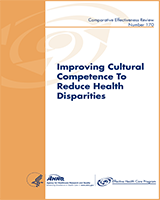NCBI Bookshelf. A service of the National Library of Medicine, National Institutes of Health.
Butler M, McCreedy E, Schwer N, et al. Improving Cultural Competence to Reduce Health Disparities [Internet]. Rockville (MD): Agency for Healthcare Research and Quality (US); 2016 Mar. (Comparative Effectiveness Reviews, No. 170.)
- Analytic Framework - Improving Cultural Competence to Reduce Health DisparitiesAnalytic Framework - Improving Cultural Competence to Reduce Health Disparities
- Quality Assessments From Nelson Report - Menopausal Symptoms: Comparative Effect...Quality Assessments From Nelson Report - Menopausal Symptoms: Comparative Effectiveness of Therapies
- List of Excluded Studies - Stroke Prevention in Patients With Atrial Fibrillatio...List of Excluded Studies - Stroke Prevention in Patients With Atrial Fibrillation: A Systematic Review Update
- Evidence Tables for Sublingual Immunotherapy Versus Subcutaneous Immunotherapy -...Evidence Tables for Sublingual Immunotherapy Versus Subcutaneous Immunotherapy - Allergen-Specific Immunotherapy for the Treatment of Allergic Rhinoconjunctivitis and/or Asthma: Comparative Effectiveness Review
- Risk of Bias Assessment - Pharmacokinetic/Pharmacodynamic Measures for Guiding A...Risk of Bias Assessment - Pharmacokinetic/Pharmacodynamic Measures for Guiding Antibiotic Treatment for Hospital-Acquired Pneumonia
Your browsing activity is empty.
Activity recording is turned off.
See more...

